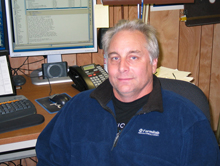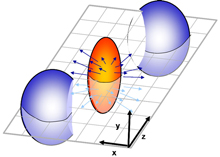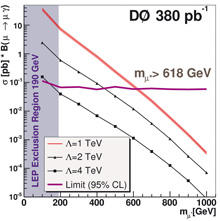 | Thursday, October 26, 2006 |
|
Thursday, October 26 THERE WILL BE NO ALCPG ILC PHYSICS AND DETECTOR SEMINAR THIS WEEK THERE WILL BE NO ACCELERATOR PHYSICS AND TECHNOLOGY SEMINAR TODAY
Friday, October 27
Saturday, October 28 Click here for a full calendar with links to additional information. |
|
Extended Forecast |
Secon Level 3 |
|
Thursday, October 26 -Bavarian Cheese -Grilled Chicken Cordon Bleu Sandwich -Chimichangas -Chicken Marsala -Smoked Turkey Melt -Assorted Slice Pizza -South West Chicken Salad with Roasted Corn Salsa |
|
Wednesday, October 25
Chez Leon Menu |
| Fermilab Today is online at: http://www.fnal.gov/today/ Send comments and suggestions to today@fnal.gov Fermilab Today archive Fermilab Today PDF Version Fermilab Result of the Week archive Fermilab Safety Tip of the Week archive Fermilab Today classifieds Subscribe/Unsubscribe to |
| After all these years, Ewald jams with a Chicago band | ||
| ||
|
Ever since designer Kerry Ewald was little, he wanted to play the guitar. "I'm from an Irish family, and my mom made me take accordion lessons," he said. "But you know, when you're a kid you want to play something cool."
So after his older brother joined the Navy and gave the teenaged Ewald his Stratocaster, he began to play the guitar in a Romeoville garage-band called the "Trendels." "I had a deal with my mom," said Ewald. "I could get equipment if I agreed to bus tables in her restaurant all summer." That was in 1971.
After that, Ewald started working at Fermilab as a machine shop assistant. He remembers helping build Robert Wilson's sculpture "Broken Symmetry" from the melted steel of a navy ship, and shearing square bits to form the donut-shaped sculpture that sits behind the Wilson Hall cafeteria. Now, 32 years later, he is a senior design drafter who uses programs like IDEAS to accommodate the needs of physicists. "It's like the machine shop except you don't get your hands dirty," he said. But Ewald has not played guitar much since he started working at Fermilab. Between designing parts for the most complicated machines in the world and spending weekends with a son from a former marriage, there was no time. "My son played basketball and we rode ATV's and I watched him grow up," said Ewald. "He is my best friend." After Ewald's son was grown (they were best men in each other's weddings), Ewald started to re-learn his adolescent passion. "It was weird to get back into the guitar after all those years," he said. "Now I've gotten to the point where I am even learning new things."
After "jamming" for a few years with fellow TD engineer Jeff Brandt and Fermilab docent Mary Hawthorne, Ewald joined the Robert Kramer Band, a Chicago-based group he says "sounds like rhythm and blues mixed with jazz, with vocals like Sting's from the Police. Playing in a band is like being married, except to a bunch of people," said Ewald. "Luckily all these guys are really cool."
The Robert Kramer Band will perform this Friday at Katrina's night club in Chicago. You can learn more about the band and the upcoming show here.
|
Probing the perfect liquid with the STAR grid
| ||
|
Microseconds after the Big Bang, the universe consisted only of a soup of free quarks and gluons. Experiments at the Relativistic Heavy Ion Collider (RHIC) at Brookhaven National Laboratory seek to reproduce this soup-called the quark-gluon plasma-by creating "little bangs" from high-energy collisions of heavy nuclei. The Open Science Grid's software stack helps the STAR experiment study the quark-gluon plasma in the laboratory by bringing its far-flung computing resources into a uniform environment.
Recent findings from STAR and other experiments have shown that the quark-gluon plasma behaves like an extraordinarily perfect liquid that flows with little resistance. To measure the properties of this perfect liquid, physicists must sift through the ashes from millions of little bangs, or collisions of two nuclei. One quantity that can reveal the properties of matter at these very small scales is the "elliptic flow" of particles in the STAR detector.
|
|
New York Times, October 24, 2006: Knowing the Universe in Detail (Except for That Pesky 96 Percent of It) Hardly anyone remembers now, but 1991 was a bad year for the Big Bang. Astronomers were having more and more difficulty reconciling their models of the explosion that gave birth and impetus to the expanding cosmos with the structure of the modern universe, in particular the discovery of strings of clusters and so-called superclusters of galaxies going hundreds of millions of light-years across the sky. There was a rash of articles in prestigious journals like Science and even this newspaper saying that major elements of the model, or even the Big Bang itself, might have to be junked. "Big Bang Blown to Bits," read one headline I remember.
I took all this rather personally because the publication of my first book, which was about cosmology, coincided with the appearance of these headlines. The cosmic jig was up, and I wasn't getting invited onto any talk shows.
|
| Will history repeat itself? | ||
|
Particle physics has a rich history of uncovering the substructure of particles that make up our universe. From the atom to the proton to the quark, smaller and smaller constituents have been observed as quickly as experimental technology has advanced.
A century-long search has uncovered exactly three generations of particles (quarks and leptons) that are believed to be fundamental. However, the Standard Model of particle physics does not suggest why this scenario should be expected. One possible explanation is that these particles are not fundamental, point-like particles, but rather composed of even smaller objects. If, for example, the muon (written as μ) were a composite particle, one might expect "excited states" (written as μ* ) similar to the muon, but with a higher mass. Such a particle would decay into its "ground state"--a muon plus a photon. This decay is analogous to the decay of an excited atom, falling back to its ground state via photon emission like a marble on a hill (excited state) rolling down to the bottom of the hill (ground state). Theory predicts a μ* could be made by colliding a quark and antiquark, making the Tevatron a good hunting ground. Although the mass of a μ* is unknown, its experimental signature could be reconstructed from the measured daughter particles (the muon and photon). At high masses (greater than 200 times the proton mass) the DZero experiment has observed zero events. This null observation of excited muons can be directly translated to an upper limit on the rate of μ* production. For a model predicting muon structure smaller than 1/5000th the size of a proton, a μ* with a mass below 618 GeV/c2 is excluded at 95 percent confidence level. There's no evidence yet for its existence, but if history is planning to repeat itself, DZero physicists will be listening. | ||
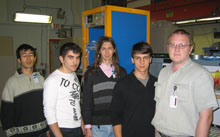 |
||
Above, from right: Forward muon system group leader Andrei Schukin (IHEP, Protvino) with students Oleg Stenyakin (IHEP, Protvino), Sergei Evstyukin, Simon Oganesian and Vadim Oreshkin (all PNPI, St. Petersburg) together with other DZero muon group members provide stable and efficient operation of the muon system critical for excited muons search and many other DZero studies. Below, from left: Thomas Hebbeker, Arnd Meyer, and Jan Coenen contributed to this analysis, with Jan as the main analyzer.
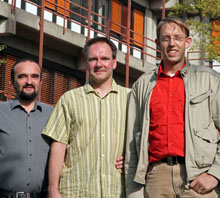 | Result of the Week Archive
|
|
October 23 - 25 - Three stores provided 14 hours and 50 minutes of luminosity - Bad cable at TeV B4 cryo system causes two quenches - Safety system glitch causes store abort - D17 separator spark Read the Current Accelerator Update Read the Early Bird Report View the Tevatron Luminosity Charts |
|
GSA Halloween Party GSA will have its annual Halloween party in the Kuhn Barn on Friday, Oct 27 at 7:30 p.m. Come, hang out and enjoy snacks and beverages and candy. You can wear your favorite Halloween costume for a shot at a prize and join in the pumpkin carving contest! RSVP to kendallm@phys.columbia.edu.
Give an old coat to
Employee Art Show |
| Security, Privacy, Legal | Use of Cookies |
